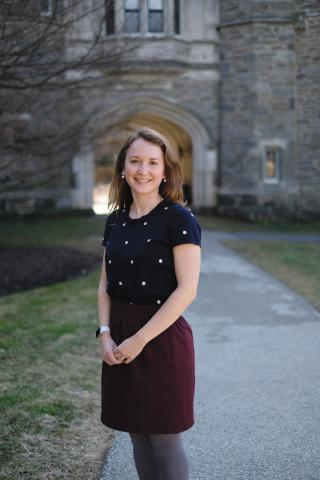A Knotty Problem
Untying a mathematical knot may unlock the mysteries of the universe.
Simple knots in the form of bowties and shoelaces spruce us up. As bowlines and hitches, they keep us safe.
For topologists, not to mention astrophysicists and molecular biologists, another kind of knot—a particular mathematical knot—may help untangle the structural mysteries of DNA and even the universe.
And Samantha Pezzimenti, Ph.D. ’18, is hot on its trail. Her research area falls in the general category of topology, specifically contact topology and symplectic geometry, and her dissertation focused on a particularly intriguing class of knots—Legendrian knots—and surfaces they can bound called Lagrangian surfaces.
Unlike your standard-issue knot, mathematical knots form an endless loop. For the technically inclined, they are defined as a smooth embedding of the circle into R3.
For the mathematically uninclined, Pezzimenti sets the stage with an explanation of the simple mathematical knot and the basic idea behind knot theory: “If you take a piece of string, tie a knot in it,” she says, “and attach the ends together, that’s a mathematical knot. And you can study all sorts of properties of these knots and classify them.”
But, she continues, “if I take one piece of string, tangle it up, and attach the ends, and then I do the same to another piece of string, how do I know if those two knots are the same or different? That may seem like a simple idea, but to rigorously prove that two knots are equivalent is actually very difficult.
“And that’s what knot theory is all about.”
Legendrian knots are mathematical knots with a difference. Unlike their less complicated cousins, they exist in a geometric space called a contact structure. “Think of three-dimensional space,” Pezzimenti explains, “with a plane associated with each point. Moving along the y-axis, these planes twist but never become vertical. A Legendrian knot lives in this space, and at every point on that knot, one of those planes has to be tangent to the knot.”
What that means for the Legendrian knot is what engages Pezzimenti. “Because no part of the knot has vertical tangency,” she says, “the trace of the knot has to take a long loop-de-loop path to enclose the ‘endless loop.’”
“Basically, a Legendrian knot has this extra geometric structure—it looks like a cusp—that changes its shape. And it turns out that several properties that are characteristic of simpler mathematical knots don’t hold for Legendrian knots.”
The applications, she explains, are more than theoretical. “It turns out that what we can learn from the properties of Legendrian knots can tell us about smooth knots as well, and smooth knots have several real-world applications—for example, the knotting of DNA strands is all about knot theory.”
Published on: 11/14/2018

